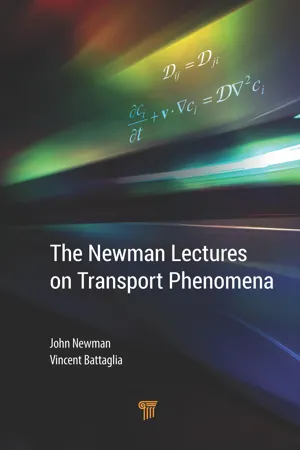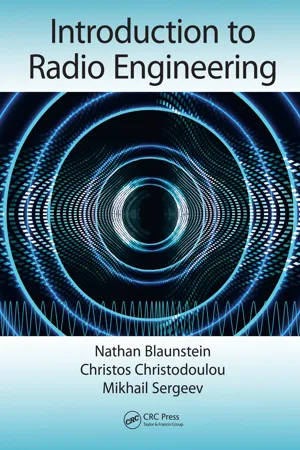Curl of a Vector Field
The curl of a vector field is a measure of the rotation or circulation of the field at a given point. It is a vector quantity that describes the tendency of the field to swirl around that point. In engineering and technology, the curl is used to analyze fluid flow, electromagnetism, and other phenomena involving rotational behavior.
4 Key excerpts on "Curl of a Vector Field"
- eBook - ePub
Liquid Crystal Displays
Fundamental Physics and Technology
- Robert H. Chen(Author)
- 2011(Publication Date)
- Wiley(Publisher)
...It can thus be seen that there must be a relative difference, otherwise that component of the curl will be zero and will have no contribution to the overall curl. It might be helpful again to think of the different speeds and directions of water flow around the paddlewheel for one plane. Similarly, the y- component of the curl is calculated by subtracting the changes in the magnetic vector components in the zx -plane, and the z -component of the curl is calculated by subtracting the changes in the magnetic vector components in the xy -plane. Thus all the values of the changes in magnetic field components are reflected in their relative changes, together constituting a three-dimensional curling motion depending on the relative values of the changes in the magnetic vector components. The calculation itself is performed efficaciously by simple Gaussian elimination in a system of simultaneous equations utilizing the convenient determinant as the operational scheme. The definition of the curl given above as a limit in space illustrates how Maxwell “mathematicized” Faraday’s intuitive field, that is, wire coils and magnets all can be taken to their infinitesimal limit at a point in space, and all the points in space constitute a mathematical field. So the substantive constituents of electromagnetism were abstractly reduced to their mathematical essence by Maxwell’s equations. Finally, an intuitive understanding of the divergence and curl can be given in the well-known and often-used vector relation This is simply stating that a curling point has no divergence, which when one thinks about it, makes eminent sense, since a curling field apparently can not have a radially emanating flux perpendicular to its curling motion. Light Is an Electromagnetic Wave Maxwell’s equations can be said to have provided the mathematical formulation of Faraday’s intuitive field and successfully described the observed electromagnetic phenomenon of the time; that alone is a great achievement...
- eBook - ePub
- John Newman, Vincent Battaglia, John Newman, Vincent Battaglia(Authors)
- 2020(Publication Date)
- Jenny Stanford Publishing(Publisher)
...Appendix A Vectors and Tensors You have seen that some of our equations, such as the equation of motion, have become quite lengthy. This frequently leads one to introduce vector notation, which has several advantages: 1. The equations become considerably more compact when written in vector notation. 2. The equations have significance independent of any particular coordinate system. 3. It is easier to grasp the meaning of an equation (after the vector notation becomes familiar). For the present, you may regard vector notation as a form of shorthand writing. However, it would be a good idea for you to develop an intuitive feel for the significance of some of the more common vector operations. A vector has both magnitude and direction and can be decomposed into components in three rectangular directions: The divergence of a vector field is This quantity is a scalar whose physical significance can be seen most easily from the continuity equation The mass flux is ρ v, showing the direction and magnitude of mass transfer per unit area, and ∇·(ρ v) represents the “rate of mass flowing away from a point.” Hence the name “divergence.” We might call −∇·(ρ v) the “convergence” of the mass flux r v. Then the equation of continuity says Rate of accumulation = Rate of convergence or net input. The Curl of a Vector Field yields another vector. When v is the fluid velocity, Ω is known as the “vorticity,” which may be regarded as the angular velocity (radians/second) of a fluid element. This vector operation will be used very seldom (if at all) in this course. The gradient of a scalar field is a vector. The gradient of ρ shows the change of density with position. The direction of the gradient shows the direction of the greatest change, and the magnitude is the rate of change in this direction. The gradient of a vector field, on the other hand, is a tensor...
- eBook - ePub
- Nathan Blaunstein, Christos Christodoulou, Mikhail Sergeev(Authors)
- 2016(Publication Date)
- CRC Press(Publisher)
...Usually, the electric and magnetic vectors can be denoted by any vectors A (E, D or H, B) as J = ∫ S A ⋅ d S = ∫ S A ⋅ i n d S = ∫ S A n d S (2.29) On the other hand, the Gauss theorem for electrostatics states that for close surfaces ∫ S A ⋅ d S = ∫ V d i v A d v ≡ ∫ V ∇ ⋅ A d v (2.30) Now, we can define the divergence of the. vector A as div A = d J d v = The flux through dS at point r The small volume around point r (2.31) or in the integral form as div A ≡ ∇ ⋅ A = lim V → 0 ∫ S A ⋅ i n d S V ≡ ∂ A x ∂ x + ∂ A y ∂ y + ∂ A z ∂ z (2.32) Comparing Equations 2.24 and 2.30, one can note that for the magnetic field, div B = 0. Such a field is called solenoidal in the literature. 2.5.2.3 Integral Presentation of Curl Operator We can obtain the integral presentation of curl (or “del cross”) operator by considering some cylindrical surface S with volume V, which has this surface as a boundary (see Figure 2.8). Using the Gauss theorem, we have for any vector A ∫ S A × d S ≡ ∫ S n × A d S = ∫ V c u r l A d v ≡ ∫ V ∇ × A d v (2.33) We can define curl of any vector A as a limit for V → 0 of ratio (see Chapter 1) c u r l A ≡ ∇ × A = lim V → 0 ∫ S n × A d S V (2.34) If so, the projection of curl vector at the normal N is. equal: [ c u r l A ] N = N ⋅ c u r l A Now, according to Definition 2.34, the projection of the curl vector at the normal N can be presented. as [ c u r l A ] N = N ⋅ c u r l A = lim V → 0 N ⋅ ∫ S n × A d S V = lim V → 0 ∫ S n ⋅ (A × N) d S V = lim V → 0 ∫ S A ⋅ (n × N) d S V = 0 Figure 2.8 Geometrical illustration of integral presentation of curl operator. because n ‖ N, and according to above definitions, we obtain n × N = 0...
- eBook - ePub
Engineering Electrodynamics
Electric Machine, Transformer, and Power Equipment Design
- Janusz Turowski, Marek Turowski(Authors)
- 2017(Publication Date)
- CRC Press(Publisher)
...– j ωμσ(T − grad V m) + curl J extern. is usually resolved by the finite-element method (FEM) with the help of boundary integral circuits. 2.2.4.4 Hertz Vector P Ref. [ 2.7 ] serves rather for simultaneous description of wave processes in electromagnetic fields of higher frequencies. It is expressed by the equation P = c 2 ∫ A ⋅ d t (c = 3 × 1 0 8 m / s) (2.69) After determination of the vector P with the help of the wave equation ∇ 2 P = 1 c 2 ∂ 2 P ∂ t 2 (2.70) one can find all the remaining field quantities,. like A = 1 c 2 ∂ 2 P ∂ t 2 (2.71) B = curl A = 1 c 2 curl ∂ 2 P ∂ t 2 (2.72) V = - d i v P (2.73) E = grad V - ∂ A ∂ t = grad div P - 1 c 2 ∂ 2 P ∂ t 2 (2.74) 2.2.4.5 Maxwell’s Stress Tensor T ↔ J. Turowski [1.15, 1.17] helps to convert electromagnetic per-unit volumetric forces f L (2.8) into the resultant surface force F = ∫ V f L ⋅ d V = ∮ S T n ⋅ d S (2.75) where f L = ρ E + J × B = ε (E div E + B × ∂ E ∂ t) − μ H × curl H = div T n —Lorentz force density [1.17]; T n is the vector of per-unit surface force, which is a projection of the Maxwell’s stress tensor T ↔ to the normal to body surface. Generally, the Maxwell’s stress. tensor T ↔ = ε (n ⋅ E) E + μ (n ⋅ H) H - 1 2 (ε E 2 + μ H 2) n (2.76) and its elements are T i j = ε ⋅ E i E j + μ ⋅ H i H j - 1 2 (ε E 2 + μ H 2) i, j = 1, 2, 3 (2.77) The component. d F i of the force d F transferred by surface element d S i of the vector d S is d F i = Σ j = 1 3 T i j d S j (2.78) From Equation 2.76 it follows that the modulus of surface force density of magnetic field is | T ↔ | = 1 2 μ H 2 (2.79) The Maxwell’s stress tensor is a very practical and useful tool for calculating forces on iron surfaces from the result of field distribution in the gap of electric machines and apparatus. Example (J. Turowski: Coupled Fields. [1.17/2], pp. 252–253) The force F acting on a surface S of the stator or rotor of electric...



